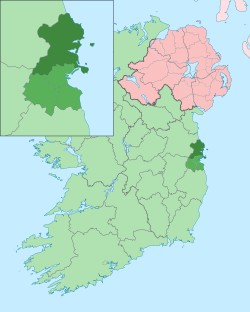Lusk, Dublin
Lusk (Irish: Lusca) is a small town in Fingal, Ireland. The town is located about 20 km (12 mi) north of Dublin city centre.
Lusk Lusca | |
|---|---|
Town | |
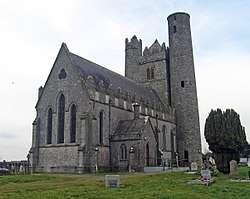 Church of Ireland and round tower at Lusk | |
 Lusk Location in Ireland | |
| Coordinates: 53.526°N 6.167°W | |
| Country | Ireland |
| Province | Leinster |
| County | Dublin |
| Local Authority | Fingal County Council |
| Elevation | 25 m (82 ft) |
| Population (2016)[1] | |
| • Total | 7,786 |
| • Density | 4,052/km2 (10,490/sq mi) |
| Time zone | UTC±0 (WET) |
| • Summer (DST) | UTC+1 (IST) |
| Eircode routing key | K45 |
| Telephone area code | +353(0)1 |
| Irish Grid Reference | R746888 |
Toponymy
The name "Lusk" is said to date back to Saint MacCullin, who founded a church there c. 450. Oral tradition suggests MacCullin may have either lived in or been buried in a cave and that the name "Lusk" derives from an old Irish word Lusca meaning 'cave' or 'underground chamber'. MacCullin died in c. 497 and his feast day was 6 September.[2] The area was known as Bregia in pre-Christian times and was said to have been birthplace to Cú Chulainn's wife, Emer in Irish mythology.
History
The settlement of Lusk has been associated with St. MacCullin since c. AD 450. The place also had associations with St. Maur, who nowadays connects with Rush (RosEo). The ruins of St. Maur's original church, or more likely its later replacement, are at the top of Whitestown hill, firmly in the parish of Rush. Lusk was plundered and burned several times in the 8th and 9th centuries by marauding Vikings, who eventually built a permanent settlement at Dubh Linn, now Dublin.
The only tangible remnant of the early Christian foundation at Lusk is the round tower. It is adjacent to a Norman square tower built against it in the 15th century. This building has three matching (smaller) towers at its corners. The square tower holds several medieval tombs including that of James Bermingham (1527) and the double-effigy tomb of Christopher Barnewall and his wife Marion Sherle (1589). The Church of Ireland church dates from 1847 by Joseph Welland, and was designed in an Early English Gothic style.[3] While standing on the right side of the castle looking up one of the bricks in the building has a stone image of St. Macullin's face.
.jpg)
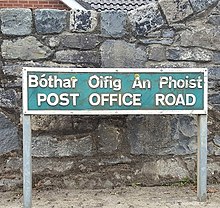
The round tower at Lusk was built in the 10th or 11th century. It stands 27 m high (originally nearly 32 m high). Inside are nine storeys including the basement making it highest number of any round tower. Each floor is lit by single-lintelled windows which vary in size. Two of these windows have been blocked up where they face unto the wall of the belfry. Just under the cap there are 4 windows facing the cardinal points. They are quite small and narrow. The original conical cap has been replaced by a flat timber roof. The flat-headed doorway, which originally would have been some 2.6 m above the ground level is now less than 1 m above the ground.[4]
Fingal is the name given to that part of present-day North County Dublin bounded by the Tolka River to the south and the Delvin River to the north. Fingal is considerably older than Dublin City, which was established by the Norsemen c. 900 AD around the 'dubh linn' or black pool. Before Christendom and St. MacCullin, the area was the Celtic "Bregia", birthplace of Cú Chullain's wife, Emer whose clan resided in or near what we now know as Lusk.
Lusca Irish Wine named after the Irish for Lusk, by Llewellyns Orchard,[5] is one of the few Irish Wine producer using grapes grown in Ireland.
On 26 May 2005 there was an attempted armed robbery of Lusk Post office. During this attempted robbery two gang members were shot dead by Gardaí. The total incident lasted 20 seconds. In 2007 a third gang member was given a 10-year jail sentence for his role in the deadly raid.[6]
To facilitate the increased population in this part of north county Dublin a new, larger, state-of-the-art post office was opened in 2016. The license was transferred from the early 20th century post office on Post Office Road to the new facilities on Station Road.[7]
Population
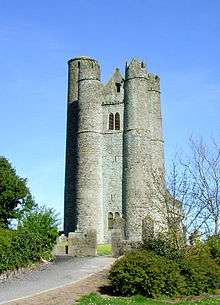
The population of the village has quadrupled since the turn of the 21st century, with people coming from Dublin city, other parts of the EU, Africa, South America and parts of Asia. According to the Central Statistical Office, 62% of all private dwellings in Lusk were built in the five years between 2001 and 2006. Census figures for the same period show a doubling of population boom from c.2, 500 to over 5, 200.[8][9] During most of the 20th century, the population remained fairly static. Census returns for 1901 and 1911 show a population boom from about 300 to 600. Figures are available for Lusk, Dublin from the early 1950s that show a population of 513 for the village.[10] Due to massive emigration in Ireland throughout the 1950s and 1960s the population of Lusk declined. In the mid-1950s for instance, the total number of children in the old NS, boys and girls, never was higher than 120. The National School opened in 1956 with that number. This primary school was replaced in 2018. The new building is located slightly north of the site of the former 1950's building, which was demolished to allow construction.
Amenities
There are four national schools in the area: Lusk NS, Hedgestown NS, Corduff NS and Rush and Lusk Educate Together NS.[11] In August 2013 these were complemented by a secondary-level education institute, Lusk Community College. The Educate Together school was the subject of adverse findings on fire safety in 2015, concluding that the building was secure for only 20 minutes in the event of fire, rather than the required 60 minutes, and over 800,000 euro of works had to be done. Problems later arose with other schools built by the same firm, Western Building Systems. There were two overriding concerns that prompted a public backlash: the lack of cavity barriers in walls and the non-existence of special intumescent paint.[12]
Lusk Community Council Ltd (LCC) was set up to look after the village and liaise with local government and councillors. LCC is a voluntary organisation whose responsibility has been to manage the Carnegie Library hall and the Old Church hall by the round tower. They also run the St Patrick’s Day parade each year.
The village accommodates many different social clubs and activities:
- Lusk United AFC soccer club
- The Round Towers GAA club
- 153rd Lusk Scouts
- Lusk Judo club
- The Black Raven pipe band
- Lusk branch of the Irish Countrywomen's Association
- Lusk Kick-boxing Club
- Lusk Athletics Club
- Lusk Heritage Group
- Lusk Tidy Towns group
- Lusk Golf Society
- Drama School
- Lusk Senior Citizens’ Group
- Lusk St Vincent de Paul Society
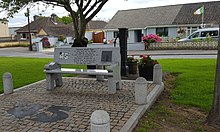
Lusk is home to a number road motorbike races, with major annual motorcycle road races, such as the Skerries 100 and Killalane Road Races, in the area. A well-known road racer from the area, Martin Finnegan was killed in a tragic accident at the Tandragee 100.[13].[14] A memorial to Martin Finnegan was dedicated close to the grounds of his parish church. Also in his memory the Martin Finnegan Trophy is awarded to the fastest lap by an Irishman at the Isle of Man TT.[15]
Religion
St. MacCullin’s Catholic Church serves as the parish church for the locality. St. MacCullins Church of Ireland church now houses Lusk Heritage Centre.[16] The Church of Ireland parish of Lusk is now grouped for administrative purposes with St. Columba's of Swords
Transport
The railway station of Rush & Lusk is about 2km east and is shared with the coastal settlement of Rush.
The Dublin Bus routes 33, 33a (taken over by Go-Ahead Ireland on 2 December 2018) and 33x also run through the area.
Fingal Express is a privately owned coach service from Skerries, Rush and Lusk to Dublin City Centre and UCD.
Twinning
Lusk is twinned with Thorigné-Fouillard located in Brittany, France. The twinning process was completed on Sunday, May 2nd, 1993. On April 27th 2011, a delegation of 27 visitors from the Breton region arrived in Lusk and were greeted by the Mayor of Fingal, Cllr Ken Farrell.[17]
See also
- List of abbeys and priories in Ireland (County Dublin)
- List of towns and villages in Ireland
References
Citations
- "Population Density and Area Size 2016 by Towns by Size, CensusYear and Statistic". Central Statistics Office (Ireland). Retrieved 2 August 2017.
- A Dictionary of Irish Saints, 2011, p. 415.
- Lusk Church and Tower on archiseek.
- The Irish Round Tower: origins and architecture explored, 1999, p. 139.
- Lusca Irish Wine history.
- Irish Independent, 10-7-2019.
- Irish Independent, 05-03-2016.
- Lusk town Demographics in the 2002 Census of Population, 2003.
- Lusk town Demographics in the 2006 Census of Population, 2007.
- The Survey Gazetteer of the British Isles, 05-01-1953.
- Lusk Community Council Information on local Schools.
- The Irish Examiner, 10-7-2019.
- Belfast Telegraph, 05-03-2016.
- Fingal Independent, 2015-01-05.
- North County Leader, 23-06-2009.
- Curious Ireland.
- Fingal Independent, 10-7-2019.
Sources
Newspapers
- "Man gets 10-year Sentence for Role in Deadly Raid". BreakingNews.ie . Dublin. 30 April 2007. Retrieved 14 July 2020.
- "Lusk celebrates Launch of new Post Office". Fingal Independent. Swords town, Dublin. 5 March 2016. Retrieved 15 July 2020.
- O'Cionnaith, Fiachra (8 October 2015). "Audits at Five Schools over Fire Safety Fears". The Irish Examiner. Cork city, Ireland. Retrieved 7 May 2020.
- Dougan, Patrice (10 January 2012). "Motorbike Racer Martin Finnegan killed by Failing Brake". Belfast Telegraph. Belfast. Retrieved 15 July 2020.
- "Lusk mourns the loss of road racer, Noel 'Smurf' Murphy who dies racing in Armagh". Fingal Independent. Swords town, Dublin. 5 January 2015. Retrieved 15 July 2020.
- Manning, John (13 April 2011). "French 'twins' to make trip to town". Fingal Independent. Swords town, Dublin. Retrieved 19 January 2019.
- "First Winner of Martin Finnegan Trophy". North County Leader. Swords town, Dublin. 23 June 2009. Retrieved 19 January 2019.
Books
- Ó Riain, Pàdraig (2011). 'A Dictionary of Irish Saints. Dublin: Four Courts Press.
- Lalor, Brian (1999). 'The Irish Round Tower: origins and architecture explored. Dublin: Collins Press. ISBN 1-898256-64-0.
- Director General at the Ordnance Survey (1953). Survey Gazetteer of the British Isles 10th edition. Edinburgh: John Bartholomew Publishing.
Online sources
- archiseek. "Church and Tower". Lusk in 1847.
- Llewellyn’s Orchards. "Lusca Irish Wine". Products Overview.
- Lusk Community Council. "Schools in the Parish". Information in the Area.
- Curious Ireland. "Visiting Information". Saint MacCuillin’s Church.
- Central Statistics Office (CSO) (2003). 2002 Saps Themes - Towns with Population of over 1,000 in the 2002 Census of Population. Dublin, Ireland: Central Statistics Office.
- Central Statistics Office (CSO) (2007). Lusk data in the 2006 Census of Population. Dublin, Ireland: Central Statistics Office.
